OPPO Find 5 Review
by Vivek Gowri on May 29, 2013 6:55 AM EST- Posted in
- Smartphones
- Qualcomm
- Mobile
- APQ8064
- OPPO Find 5
We’re pretty familiar with APQ8064 by now, it’s just quad-core Krait (or Krait 200 in the new Qualcomm branding scheme) and Adreno 320. Five months ago, this was world class, though obviously now outclassed by Snapdragon 600-based handsets. Phones are iterating very quickly nowadays, so it’s hard for any one SoC to stay on top of the market for more than 6 months at a time. Snapdragon S4 Pro devices started hitting shelves in November, and by the end of April, handsets with the next generation Krait were already hitting market. Even now, there are a multitude of quad-A15 handsets as well as Snapdragon 800 right around the corner. Ah yes, the never ending iterative cycle of the smartphone world.
Krait 200 doesn’t count as slow, but it clearly isn’t as fast as Krait 300 on a per-clock basis, and the higher frequencies of the newer Snapdragon parts gives those a solid performance edge. I don’t really have much else to say - this isn’t a new SoC, and we’ve seen it a few times - so I’ll just post the benchmarks. I, like Brian and Anand, am none too thrilled about the state of CPU benchmarks on Android, since they’re all browser-based, but until we get something better, this is what we have to work with.


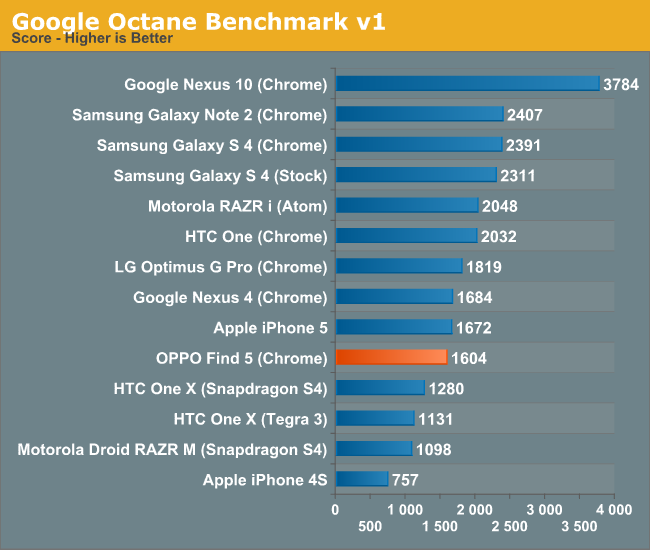
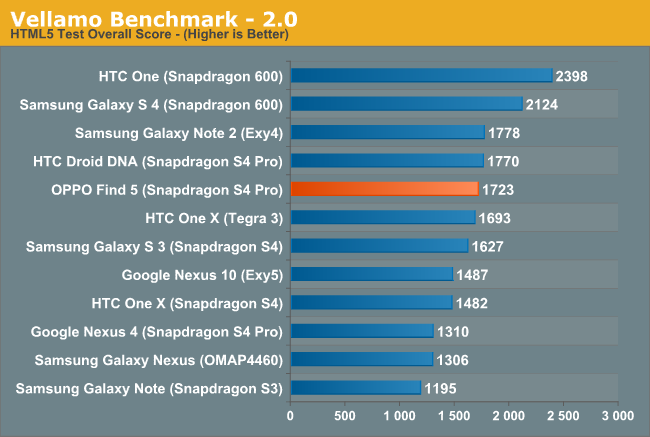
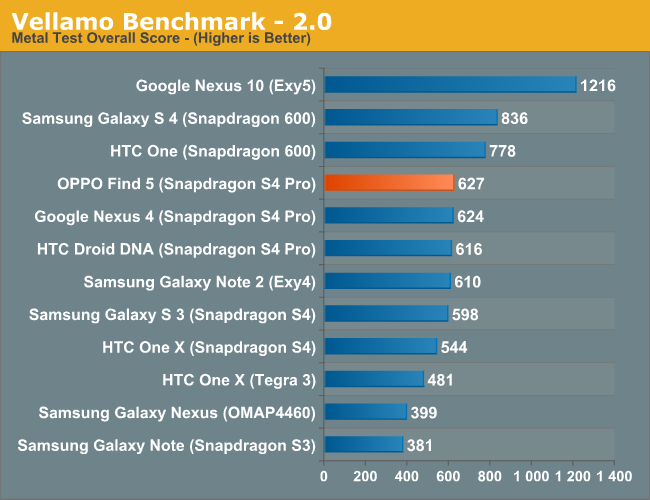
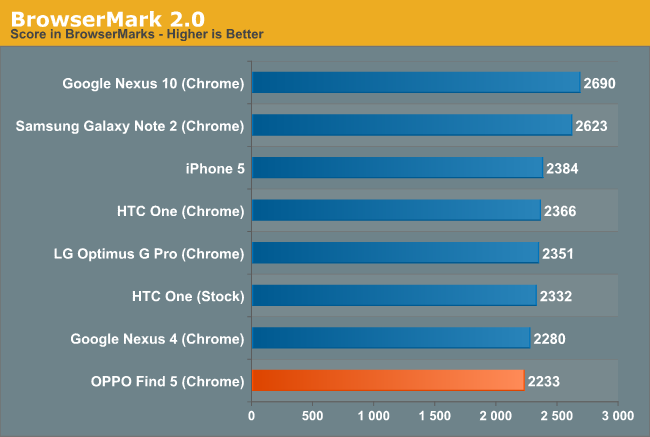
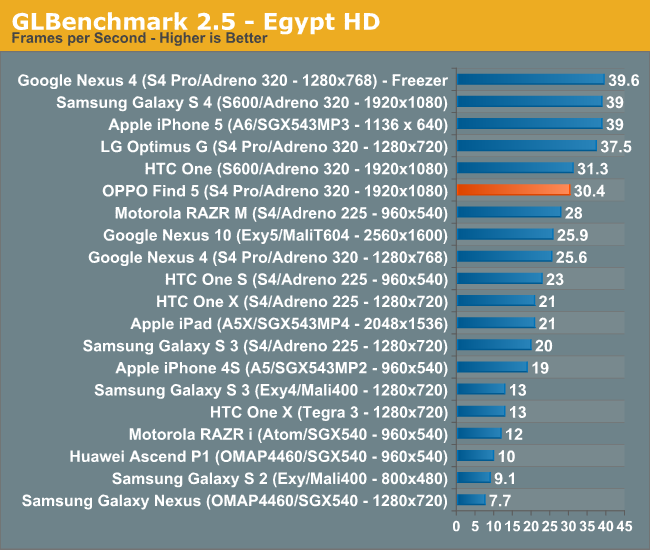
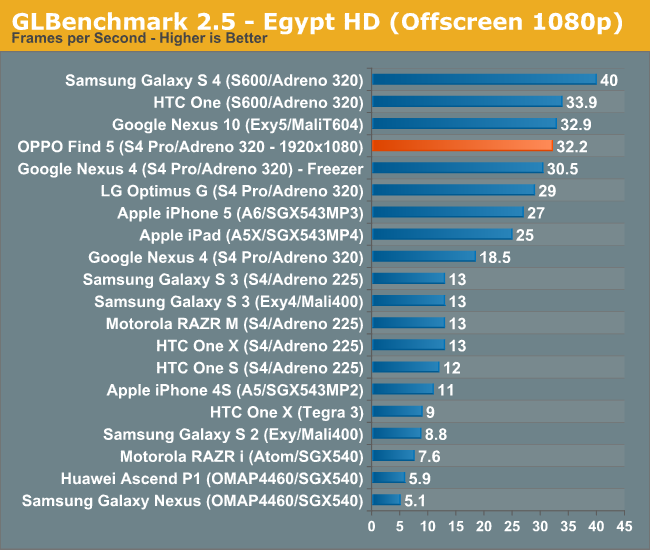
Power management is handled by Qualcomm’s PM8921 PMIC, which we’ve also seen in the Nexus 4, amongst others. The hardware here is actually pretty similar to what we see in the latest Nexus device (other than the display, camera, and baseband, which I’ll get to), which is another potential reason why it’s seen surprisingly quick adoption by third party developers (especially getting official support from Paranoid Android, who usually start with Nexus devices and let others port to more mainstream handsets like the Galaxy S3).
Throttling is becoming a big deal with phones, and it’s important to address it. The throttling thresholds for the OPPO start at 72C, at which point the maximum frequency of the cores drops to 1.18GHz, then 810MHz at 75C, eventually clocking all the way down to 384MHz at 90C. The eventual shutdown is triggered at 120C. I’m not sure what exactly I’d have to do to a phone to get it to 120C other than literally throwing it into a fire, but there you have it. In day to day use, I didn’t see it throttle, even when running benchmarks. I did induce a throttling scenario when using a high-current tablet brick to charge the Find 5 and running GLBenchmark to stress the system, but it’s nowhere near the Galaxy S4 in terms of throttling frequency. I never had a problem with throttling on either of my personal Nexus 4s, though we all know how much trouble Brian had on his evaluation unit, so your mileage may vary here.










39 Comments
View All Comments
nathanddrews - Wednesday, May 29, 2013 - link
As far as "finger friendly" designs go, I don't really care where the buttons are as long as they are set into the phone (concave). My only complaint with my S3 is that the buttons all protrude from the body, making unwanted power, home, and volume presses extremely common. Thankfully, I have a simple, somewhat thick $7 plastic slipcase that has button cutouts so I can freely handle the phone without ever accidentally hitting the buttons.Before today, I didn't know Oppo made anything but the best Blu-ray players on the market. It's a shame that the phone doesn't live up to the precedent.
cknobman - Wednesday, May 29, 2013 - link
"I think 4.7” is the sweet spot for display size, something that was reached with the last generation of handsets. There’s not really any benefit to going with a 5” panel over a 4.7” panel beyond just having a bigger number - it’s not like jumping to a Galaxy Note-sized 5.5” or larger display, where the device ends up being more of a phablet than a handset, but it does add just enough bulk to be on the cumbersome side."I just dont understand this statement. The GS4 has a 5' screen and is physically smaller than the OPPO and HTC One. I compared the HTC One side by side with the GS4 in store and it was shorter and thinner than the HTC one and actually fit in my pocket better. I also found that the .3 extra screen did benefit me quite a bit as it provides a better viewing experience for movies and games.
MantasPakenas - Wednesday, May 29, 2013 - link
"This is obviously less of a factor in Europe and Asia, where the prices are more equivalent (the Nexus 4 is a phenomenal value in the US through the Google Play Store, but less so in the rest of the world)"Correction - I'm not sure about the whole world, but at least in Europe you can: a) buy the device via Google Play Store in major markets, and even ship it outside those major markets if you are resourceful enough; b) buy it locally, where available, at an extremely close price point (at least that's the situation in Lithuania). In these cases, Nexus 4 is competitively positioned very close to US market, ending up ca 40% cheaper than flagship devices like HTC One or SGS4...
Kristian Vättö - Wednesday, May 29, 2013 - link
a) You need a local shipping address AND credit card (VCCs don't work AFAIK) to buy from Google Play Store, hence it's basically impossible to buy one if your local Play Store doesn't carry it yet. Of course, if you a friend in one of the countries where the Nexus 4 is sold through Play Store, then it's easy (I did this to get my Nexus 4).b) Here in Finland the Nexus 4 (16GB) currently costs ~490€. I got mine for 400€ when including all the shipping costs (the device itself was ~350€ but Google charged £10 for shipping plus another £15 to ship it from UK to Finland). However, the Nexus 4 was 600€ when launched here, so I saved ~200€ back in January.
fabarati - Wednesday, May 29, 2013 - link
Holy Crap! Something is cheaper in Sweden! A 16 GB Nexus 4 can be had for ~380€ (3300 SEK). But yeah, the price of the Nexus 4 was around 4500 SEK when launched here, about 520€ at today's exchange rate.tipoo - Wednesday, May 29, 2013 - link
Is the battery situated further from the SoC than the Nexus 4 or Optimus G? As far as I know, it was actually the batterys threshold temperature that actually triggered throttling, since the two were so close. The battery could only get up to 60 degrees before complete shutdown and made the phone throttle at just 36 C.flyingpants1 - Wednesday, May 29, 2013 - link
So spec-wise, it's an Xperia Z series clone. YawnPatriciaBau42 - Wednesday, May 29, 2013 - link
If you think Phyllis`s story is astonishing,, two weeks ago mother in law basically got paid $4919 putting in ninteen hours a week an their house and their best friend's ex-wife`s neighbour did this for eight months and actually earnt more than $4919 part-time from there labtop. applie the instructions from this address, Exit35.comTAKE A LOOKflamencoguy - Wednesday, May 29, 2013 - link
A version with a Snapdragon 600 has already been announced.editorsorgtfo - Wednesday, May 29, 2013 - link
LOL @ Polyurethane. Editors or GTFO.